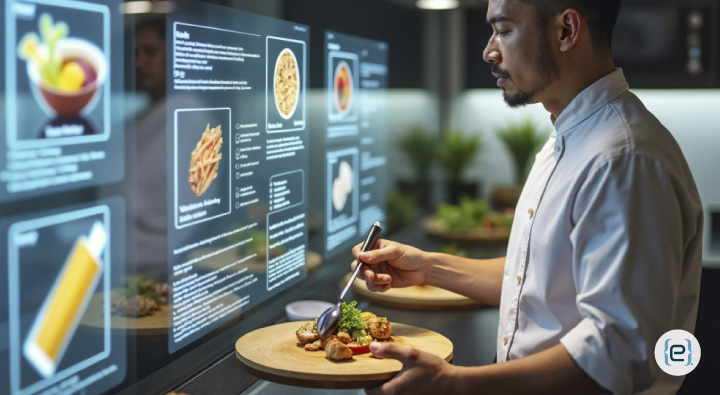The Digital Kitchen Revolution: How Technology is Reshaping Restaurant Operations


The Rise of Virtual Restaurants
Last month, while consulting for a restaurant chain transitioning to delivery-only operations, I watched your business model transform in real time. The dining industry has experienced a seismic shift since 2020, with ghost kitchens and delivery-focused concepts becoming the new frontier. My recent visit to a bustling ghost kitchen in downtown Chicago highlighted this transformation: a single facility housed eight different restaurant brands, all operating seamlessly through a sophisticated digital infrastructure.
This is more than a passing trend—it’s a fundamental reimagining of restaurant operations, fueled by changing consumer preferences and cutting-edge technology. If you want your restaurant to thrive in this new era, embracing digital transformation is no longer optional.
Behind the Digital Counter
The morning rush at a ghost kitchen is nothing like the chaos of a traditional restaurant. Instead of servers darting between tables, you’ll find staff expertly managing tablets, coordinating deliveries, and juggling orders from multiple platforms. The true heart of these operations isn’t the industrial stove—it’s the technology stack that orchestrates everything from inventory management to delivery timing.
During a recent system upgrade project, our team discovered that the average ghost kitchen relies on at least seven different software applications working in concert to keep things running smoothly. Without seamless integration, even the best menu can’t save your operation from digital disarray.
- Integrated Order Management: Ensures all incoming orders from various platforms are centralized and processed efficiently.
- Inventory Sync: Real-time tracking prevents shortages and overstock, keeping your kitchen agile.
- Delivery Coordination: Streamlines dispatch and ensures timely hand-offs to drivers.
The Technology Feast: Orchestrating Operations
Working closely with restaurant clients, I’ve seen firsthand the critical components that make or break a delivery-focused operation. Modern restaurant technology functions like a well-orchestrated symphony: point-of-sale systems communicate with delivery platforms, inventory tools sync with ordering systems, and kitchen display screens coordinate with driver apps.
Just last quarter, I helped implement a unified system for a multi-brand ghost kitchen and watched their order processing time drop by 45% once everything was properly integrated. If you’re considering a similar transformation, understanding the right point-of-sale system is essential for your operation’s success.
Data: The Secret Ingredient
Successful ghost kitchens are incredibly data-hungry. Kitchen managers analyze everything from peak ordering times to delivery radius optimization. Recently, I reviewed a client’s analytics setup that tracked real-time ingredient usage across five virtual brands, automatically adjusting supply orders based on predicted demand. This level of precision is only possible with a robust IT infrastructure supporting every aspect of your operation.
- Real-Time Dashboards: Provide instant insights into sales trends and operational bottlenecks.
- Automated Reordering: Reduces waste and keeps your kitchen ready for demand spikes.
The Essential Technology Stack
Through years of implementation experience, we’ve identified the must-have components for every delivery-focused restaurant:
- Integrated order management systems spanning multiple platforms.
- Automated inventory tracking with smart reordering capabilities.
- Kitchen production systems that optimize preparation timing.
- Delivery dispatch coordination tools.
- Real-time analytics dashboards.
- Comprehensive financial reporting systems.
Each part must work flawlessly with the others to create a seamless flow from order placement to delivery. If you’re looking for a partner to help integrate your technology, eMazzanti offers retail IT solutions tailored to your needs.
Security in the Virtual Kitchen
During a recent cybersecurity audit for a ghost kitchen client, I discovered vulnerabilities that could have exposed customer data and proprietary recipes. Digital restaurants handle sensitive information constantly—payment details, delivery addresses, customer preferences, and valuable operational data. Establishing robust security measures isn’t just about protection; it’s about building trust in an industry where your customers never see your physical location.
Scaling in the Cloud
The beauty of ghost kitchens lies in their scalability—when supported by the right technology infrastructure. Recently, I worked with a client expanding from two to six virtual brands in just three months. Their cloud-based system let them replicate their successful model across new concepts without starting from scratch. The agility provided by cloud solutions has become indispensable in this fast-moving sector.
Facing Technical Challenges
Through countless implementations, I’ve encountered common technical hurdles that can derail ghost kitchen operations:
- Integration Issues: Disjointed systems can cause order delays and inventory errors.
- Data Synchronization Problems: Inaccurate data can lead to supply shortages and missed sales.
- System Reliability: Peak hours test your infrastructure’s limits—professional IT support is crucial.
Restaurants that invest in professional IT support from the start avoid costly disruptions and keep their kitchens running smoothly.
The Future is Already Cooking
The ghost kitchen model is evolving rapidly. Automation and artificial intelligence are playing bigger roles every day. I recently toured a facility testing automated cooking systems integrated with their order management platform. Watching robots precisely portion ingredients while software optimized cooking times, I realized just how far technology has taken us from traditional kitchen operations.
Building Your Digital Restaurant Foundation
Success in the ghost kitchen and delivery restaurant space demands more than just great food—it requires a robust, scalable, and secure technology foundation. At eMazzanti Technologies, we’ve helped countless restaurant operations navigate their digital transformation, providing the expertise you need to build and maintain complex IT ecosystems. Our experience in integrating platforms, ensuring data security, and optimizing operations has made us a trusted partner for forward-thinking restaurants.
Whether you’re launching your first ghost kitchen or expanding an existing delivery operation, having a dedicated IT partner who understands both technology and the unique challenges of the restaurant industry makes all the difference.
Ready to future-proof your restaurant? Contact eMazzanti today to discover how we can help your digital kitchen thrive in this exciting new era of food service.
Recent Posts
Look Inside For Cyber and Insider Threats
In more than 20 years of speaking at events, I have noticed a recurring theme…
AI-Powered Software Slashes Law Firm Costs and Boosts Efficiency
Artificial Intelligence (AI) is transforming industries across the board, but its impact on the legal…
Make Sure Your Point of Sale System Is On Point
Point of sale (POS) systems are helpful for both retailers and customers. They let consumers…
Counter Dark Web Threats With AI-Backed Cybersecurity Tools
Businesses of all sizes today are confronting a rising number of sophisticated cyber security threats,…
A Cybersecurity Workout
Greetings! I am Carl Mazzanti, and I have been sharing my thoughts in these kinds…
Step Up Your Threat Response With Security Copilot
As we move deeper into 2025, you are probably focusing on ways to expand your…


